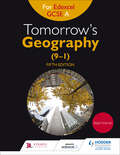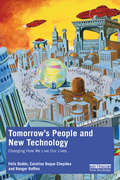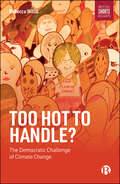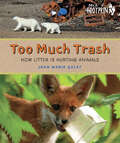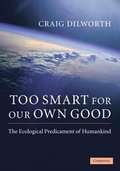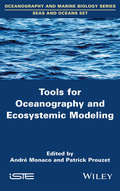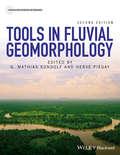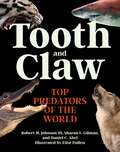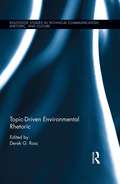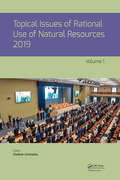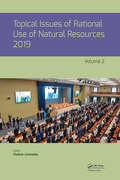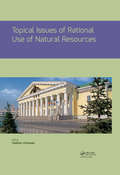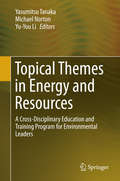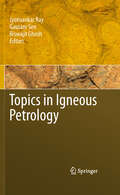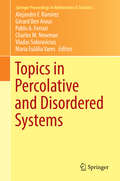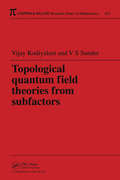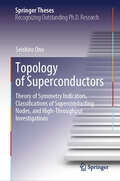- Table View
- List View
Tomorrow's Geography for Edexcel GCSE A Fifth Edition
by Steph WarrenHelp your students develop enquiring minds as they learn the geographical knowledge and skills they need through the enquiries of the new OCR B specification which include and up-to-date case studies, a wide range of activities and exam-style questions developed to support and stretch students of all abilities.- Supports students of all abilities through differentiated activities including scaffolded questions and extension questions.- Highlights opportunities for fieldwork throughout the book, and includes guidance on carrying out fieldwork.- Develops students' geographical skills including activities and clear explanations of how to use mathematical and statistical skills.- Helps students gain confidence for the exam with a variety of exam-style practice questions at different levels, with tips on how to approach them.
Tomorrow's People and New Technology: Changing How We Live Our Lives
by Felix Dodds Carolina Duque Chopitea Ranger RuffinsAs we witness a series of social, political, cultural, and economic changes/disruptions this book examines the Fourth Industrial Revolution and the way emerging technologies are impacting our lives and changing society. The Fourth Industrial Revolution is characterised by the emergence of new technologies that are blurring the boundaries between the physical, the digital, and the biological worlds. This book allows readers to explore how these technologies will impact peoples’ lives by 2030. It helps readers to not only better understand the use and implications of emerging technologies, but also to imagine how their individual life will be shaped by them. The book provides an opportunity to see the great potential but also the threats and challenges presented by the emerging technologies of the Fourth Industrial Revolution, posing questions for the reader to think about what future they want. Emerging technologies, such as robotics, artificial intelligence, big data and analytics, cloud computing, nanotechnology, biotechnology, the Internet of Things, fifth-generation wireless technologies (5G), and fully autonomous vehicles, among others, will have a significant impact on every aspect of our lives, as such this book looks at their potential impact in the entire spectrum of daily life, including home life, travel, education and work, health, entertainment and social life. Providing an indication of what the world might look like in 2030, this book is essential reading for students, scholars, professionals, and policymakers interested in the nexus between emerging technologies and sustainable development, politics and society, and global governance.
Too Hot to Handle?: The Democratic Challenge of Climate Change
by Rebecca WillisScientists are clear that urgent action is needed on climate change, and world leaders agree. Yet climate issues barely trouble domestic politics. This book explores a central dilemma of the climate crisis: science demands urgency; politics turns the other cheek. Is it possible to hope for a democratic solution to climate change? Based on interviews with leading politicians and activists, and the author’s twenty years on the frontline of climate politics, this book explores why climate is such a challenge for political systems, even when policy solutions exist. It argues that more democracy, not less, is needed to tackle the climate crisis, and suggests practical ways forward.
Too Many People?
by Ian Angus Joel Kovel Simon Butler Betsy HartmannToo Many People? provides a clear, well-documented, and popularly written refutation of the idea that "overpopulation" is a major cause of environmental destruction, arguing that a focus on human numbers not only misunderstands the causes of the crisis, it dangerously weakens the movement for real solutions. No other book challenges modern overpopulation theory so clearly and comprehensively, providing invaluable insights for the layperson and environmental scholars alike. Ian Angus is editor of the ecosocialist journal Climate and Capitalism, and Simon Butler is co-editor of Green Left Weekly.
Too Much Trash: How Litter Is Hurting Animals (Orca Footprints #27)
by Joan Marie GalatLitter is not only an eyesore but a serious threat to animals and their habitats. We can all work together to keep the planet healthy and clean. Did you know that gum on the sidewalk is litter? Even a banana peel that is thrown in a ditch is litter. Trash poses a threat to animals everywhere, including pets, farm animals and wildlife. They can get injured or trapped in the litter and even eat garbage that makes them sick. In Too Much Trash: How Litter Is Hurting Animals, we discover how garbage ends up everywhere—from city streets and the wilderness to farmland and the ocean. But there's good news: litter is a problem everyone can help prevent. Around the world, kids and adults are finding ways to take out the trash. Find out how you can help clean up the planet for all species.
Too Smart for Our Own Good: The Ecological Predicament of Humankind
by Craig DilworthWe are destroying our natural environment at a constantly increasing pace, and in so doing undermining the preconditions of our own existence. Why is this so? This book reveals that our ecologically disruptive behaviour is in fact rooted in our very nature as a species. Drawing on evolution theory, biology, anthropology, archaeology, economics, environmental science and history, this book explains the ecological predicament of humankind by placing it in the context of the first scientific theory of our species' development, taking over where Darwin left off. The theory presented is applied in detail to the whole of our seven-million-year history. Due to its comprehensiveness, and in part thanks to its extensive glossary and index, this book can function as a compact encyclopadia covering the whole development of Homo sapiens. It would also suit a variety of courses in the life and social sciences. Most importantly, Too Smart for Our Own Good makes evident the very core of the paradigm to which our species must shift if it is to survive. Anyone concerned about the future of humankind should read this groundbreaking work.
Tooele Chemical Agent Disposal Facility: Update on National Research Council Recommendations
by Committee on Review Evaluation of the Army Chemical Stockpile Disposal ProgramThe National Academies Press (NAP)--publisher for the National Academies--publishes more than 200 books a year offering the most authoritative views, definitive information, and groundbreaking recommendations on a wide range of topics in science, engineering, and health. Our books are unique in that they are authored by the nation's leading experts in every scientific field.
Tools for Oceanography and Ecosystemic Modeling
by Patrick Prouzet André MonacoStudying the Ocean Planet requires measuring and sampling instruments to feed models that take into account its complexity. This book presents the diversity of observation and monitoring techniques at various scales, but also different kinds of model that take into account some conceptual schemes incorporating various scientific knowledge. Sampling is approached via the efficiency of fishing gears; underwater acoustics is used to detect, count, identify and listen to live and mobile living resources. Bio-logging allows us to rely on the behavior of marine animals to help investigate environments that are difficult to sample by conventional means, while listing the physiological changes they undergo. Modeling is presented not only in a functional framework, but also in an exploratory design incorporating various scenarios for ecosystem changes under the pressure of global change. This ninth volume completes the "Seas and Oceans" Set that adopts a transversal approach leading to the governance and sustainable management of the marine environment.
Tools in Fluvial Geomorphology
by Hervé Piégay G. Mathias KondolfFluvial Geomorphology studies the biophysical processes acting in rivers, and the sediment patterns and landforms resulting from them. It is a discipline of synthesis, with roots in geology, geography, and river engineering, and with strong interactions with allied fields such as ecology and landscape architecture. This book comprehensively reviews tools used in fluvial geomorphology, at a level suitable to guide the selection of research methods for a given question. Presenting an integrated approach to the interdisciplinary nature of the subject, it provides guidance for researchers and professionals on the tools available to answer questions on river restoration and management. Thoroughly updated since the first edition in 2003 by experts in their subfields, the book presents state-of-the-art tools that have revolutionized fluvial geomorphology in recent decades, such as e.g., physical and numerical modelling, remote sensing and GIS, new field techniques and advances in dating, tracking and sourcing, statistical approaches as well as more traditional methods such as system concept, stratigraphic analysis, form and flow characterisation or historical analysis. This book: Covers five main types of geomorphological questions and their associated tools: historical framework; spatial framework; chemical, physical and biological methods; analysis of processes and forms; and future understanding framework. Provides guidance on advantages and limitations of different tools for different applications, data sources, equipment and supplies needed, and case studies illustrating their application in an integrated perspective. It is an essential resource for researchers and professional geomorphologists, hydrologists, geologists, engineers, planners, and ecologists concerned with river management, conservation and restoration. It is a useful supplementary textbook for upper level undergraduate and graduate courses in Geography, Geology, Environmental Science, Civil and Environmental Engineering, and interdisciplinary courses in river management and restoration.
Tooth and Claw: Top Predators of the World
by Daniel C. Abel Dr. Robert M. Johnson III Sharon L. GilmanA marvelously illustrated look at the most deadly predators on the planetTooth and Claw presents the world’s top predators as you have never seen them before, from big cats and wild dogs to sharks, reptiles, and killer whales. Blending gorgeous photos and illustrations with spellbinding storytelling, this book is packed with the latest facts about these fearsome but often misunderstood animals. It covers apex and other top predators in each major vertebrate family, discussing where and how they live, how they are faring in the modern world, and why they matter. Along the way, the authors share informative and entertaining anecdotes from their decades in the field learning about predators and reveal hard truths about the role humans continue to play in their fate. Tooth and Claw also describes conservation successes and lays out some simple but crucial steps each of us can take to protect these magnificent beasts. Are humans top predators, too? Read this amazing book and find out.Offers an unparalleled look at a side of nature rarely witnessed up closeStunningly illustrated throughout and brimming with fun factsDescribes ultimate vertebrate predators ranging from sharks and reptiles to raptors, cats, dogs, bears, and marine mammalsProvides rare insights into the biology, ecology, and conservation of top predatorsDraws on the latest findings from habitats around the worldConveys the wonders of the natural world with engaging storytelling and lively personal anecdotes
Topic-Driven Environmental Rhetoric (Routledge Studies in Technical Communication, Rhetoric, and Culture)
by Derek G. RossCommon topics and commonplaces help develop arguments and shape understanding. When used in argumentation, they may help interested parties more effectively communicate valuable information. The purpose of this edited collection on topics of environmental rhetoric is to fill gaps in scholarship related to specific, targeted, topical communication tactics. The chapters in this collection address four overarching areas of common topics in technical communication and environmental rhetoric: framing, place, risk and uncertainty, and sustainability. In addressing these issues, this collection offers insights for students and scholars of rhetoric, as well as for environmental communication practitioners looking for a more nuanced understanding of how topic-driven rhetoric shapes attitudes, beliefs, and decision-making.
Topical Issues of Rational Use of Natural Resources 2019, Volume 1: Proceedings of the XV International Forum-Contest of Students and Young Researchers under the auspices of UNESCO (St. Petersburg Mining University, Russia, 13-17 May 2019)
by Vladimir LitvinenkoTopical Issues of Rational Use of Natural Resources 2019 Vol. 1 contains the contributions in presented at the XV International Forum-Contest of Students and Young Researchers under the auspices of UNESCO (St. Petersburg Mining University, Russia, 13-17 May 2019). The Forum-Contest is a great opportunity for young researchers to present their work to the academics involved or interested the area of extraction and processing of natural resources. The topics of the book include: • Geotechnologies of resource extraction: current challenges and prospects • Cutting edge technologies of geological mapping, search and prospecting of mineral deposits • Digital and energy saving technologies in mineral resource complex • Breakthrough technologies of integrated processing of mineral hydrocarbon and technogenic raw materials with further production of new generation materials • The latest management and financing solutions for the development of mineral resources sector • Environment protection and sustainable nature management • New approaches to resolving hydrocarbon sector-specific issues Topical Issues of Rational Use of Natural Resources 2019 Vol. 1 collects the best reports presented at the Forum-Contest, and is of interest to academics and professionals involved in the extraction and processing of natural resources.
Topical Issues of Rational Use of Natural Resources, Volume 2
by Vladimir LitvinenkoTopical Issues of Rational Use of Natural Resources 2019 Vol. 2 contains the contributions presented at the XV International Forum-Contest of Students and Young Researchers under the auspices of UNESCO (St. Petersburg Mining University, Russia, 13-17 May 2019). The Forum-Contest is a great opportunity for young researchers to present their work to the academics involved or interested the area of extraction and processing of natural resources. The topics of the book include: • Geotechnologies of resource extraction: current challenges and prospects • Cutting edge technologies of geological mapping, search and prospecting of mineral deposits • Digital and energy saving technologies in mineral resource complex • Breakthrough technologies of integrated processing of mineral hydrocarbon and technogenic raw materials with further production of new generation materials • The latest management and financing solutions for the development of mineral resources sector • Environment protection and sustainable nature management • New approaches to resolving hydrocarbon sector-specific issues Topical Issues of Rational Use of Natural Resources 2019 Vol. 2 collects the best reports presented at the Forum-Contest, and is of interest to academics and professionals involved in the extraction and processing of natural resources.
Topical Issues of Rational Use of Natural Resources: Proceedings of the International Forum-Contest of Young Researchers, April 18-20, 2018, St. Petersburg, Russia
by Vladimir LitvinenkoTopical Issues of Rational Use of Natural Resources contains the contributions presented at International Forum-Contest of Young Researchers 2018 (St. Petersburg Mining University, Russia, 18-20 April 2018). The Forum-Contest is an excellent opportunity for young researchers to present their work to the scientific community involved in the extraction and processing of natural resources.The topics of the book include: • Prospecting and exploration of mineral deposits• Development of solid minerals deposits and safety of mining operations• Development of oil and gas fields and transportation of crude hydrocarbons• Modern technologies of construction work applied in the mineral complex• Metallurgy. Physical and chemical technologies of hydrocarbons treatment• Equipment, transport service and energy efficiency of mining enterprises• Economic tools of innovative development• Environmental protection• Geo information systems and nanotechnologies Topical Issues of Rational Use of Natural Resources collects the best reports presented at the Forum-Contest, and will be of interest to academics and professionals involved in the extraction and processing of natural resources.
Topical Themes in Energy and Resources
by Michael Norton Yasumitsu Tanaka Yu-You LiThis book combines issues several critical ones in the energy field (low-energy technologies, renewable energies such as the hydrogen economy, and geothermal energy). Moving towards a more sustainable world requires a complete revolution in the way we manage energy and resources. However, from an academic perspective, this theme is so broad that most educators and researchers tend to focus on just one aspect, and maintaining the broad viewpoint which is necessary for making strategic judgments becomes difficult. Tohoku University addressed this challenge when developing a new education and training program for environmental leaders and brought together the extensive range of expertise available in specific fields into one special course which forms the basis of this book. Now in one volume, both students and educators can be brought up to date on a wide range of critical issues currently being addressed in the field of energy and resources. Chapters on resources include availability (for instance, rare earth metals), extraction and recycling of metals and plastics, and technological solutions to specific waste-disposal problems. In addition, broader strategic issues such as limits to growth and the interaction between the economic system and environmental issues are addressed. Even though each chapter provides topical data and knowledge from disparate and specialized fields, the book is written at a level that is readily understandable by students from all scientific, engineering, and humanities fields.
Topics in Igneous Petrology
by Biswajit Ghosh Gautam Sen Jyotisankar RayThe second half of the past century witnessed a remarkable paradigm shift in approach to the understanding of igneous rocks. Global literature records a change from a classical petrographic approach to emphasis on mineral chemistry, trace element characteristics, tectonic setting, phase relations, and theoretical simulation of magma generation and evolution processes. This book contains contributions by international experts in different fields of igneous petrology and presents an overview of recent developments. This book is dedicated to the late Dr Mihir K. Bose, former professor of the Department of Geology, Presidency College, Calcutta, India, who actively participated in the development of this new global view of igneous petrology.
Topics in Percolative and Disordered Systems
by Charles M. Newman Alejandro F. Ramírez Gérard Ben Arous Pablo A. Ferrari Vladas Sidoravicius Maria Eulália VaresThis volume features selected and peer-reviewed articles from the Pan-American Advanced Studies Institute (PASI). The chapters are written by international specialists who participated in the conference. Topics include developments based on breakthroughs in the mathematical understanding of phenomena describing systems in highly inhomogeneous and disordered media, including the KPZ universality class (describing the evolution of interfaces in two dimensions), random walks in random environment and percolative systems. PASI fosters a collaboration between North American and Latin American researchers and students. The conference that inspired this volume took place in January 2012 in both Santiago de Chile and Buenos Aires. Researchers and graduate students will find timely research in probability theory, statistical physics and related disciplines.
Topics in Theoretical and Computational Nanoscience
by Jeffrey Michael McmahonInterest in structures with nanometer-length features has significantly increased as experimental techniques for their fabrication have become possible. The study of phenomena in this area is termed nanoscience, and is a research focus of chemists, pure and applied physics, electrical engineers, and others. The reason for such a focus is the wide range of novel effects that exist at this scale, both of fundamental and practical interest, which often arise from the interaction between metallic nanostructures and light, and range from large electromagnetic field enhancements to extraordinary optical transmission of light through arrays of subwavelength holes. This dissertation is aimed at addressing some of the most fundamental and outstanding questions in nanoscience from a theoretical and computational perspective, specifically: · At the single nanoparticle level, how well do experimental and classical electrodynamics agree? · What is the detailed relationship between optical response and nanoparticle morphology, composition, and environment? · Does an optimal nanostructure exist for generating large electromagnetic field enhancements, and is there a fundamental limit to this? · Can nanostructures be used to control light, such as confining it, or causing fundamentally different scattering phenomena to interact, such as electromagnetic surface modes and diffraction effects? · Is it possible to calculate quantum effects using classical electrodynamics, and if so, how do they affect optical properties?
Topological Degree Theory and Applications (Mathematical Analysis and Applications)
by Yeol Je Cho Yu-Qing ChenSince the 1960s, many researchers have extended topological degree theory to various non-compact type nonlinear mappings, and it has become a valuable tool in nonlinear analysis. Presenting a survey of advances made in generalizations of degree theory during the past decade, this book focuses on topological degree theory in normed spaces and its ap
Topological Phases in Condensed Matter Physics
by Saurabh BasuThe book is mainly designed for post-graduate students to learn modern-day condensed matter physics. While emphasizing an experiment called the ‘Quantum Hall effect’, it introduces the subject of 'Topology' and how the topological invariants are related to the quantization of the Hall plateaus. Thus, the content tries to deliver an account of the topological aspects of materials that have shaped the study of condensed matter physics in recent times. The subject is often quite involved for a student to grasp the fundamentals and relate them to physical phenomena. Further, these topics are mostly left out of the undergraduate curriculum, although they often require a simplistic view of the concepts involved to be presented pedagogically. The book contains examples, worked-out concepts, important derivations, diagrams for illustration, etc. to aid the understanding of the students. The book also emphasizes the experimental discoveries that put the subject in its perspective and elaborate on the applications which are likely to be of interest to scientists and engineers.
Topological Quantum Field Theories from Subfactors (Chapman And Hall/crc Research Notes In Mathematics Ser. #Vol. 423)
by Vijay KodiyalamPure mathematicians have only recently begun a rigorous study of topological quantum field theories (TQFTs). Ocneanu, in particular, showed that subfactors yield TQFTs that complement the Turaev-Viro construction. Until now, however, it has been difficult to find an account of this work that is both detailed and accessible.Topological Quant
Topological Quantum Matter
by Thomas Klein KvorningThis book offers a theoretical description of topological matter in terms of effective field theories, and in particular topological field theories, focusing on two main topics: topological superconductors and topological insulators.Even though there is vast literature on these subjects, the book fills an important gap by providing a concise introduction to both topological order and symmetry-protected phases using a modern mathematical language, and developing the theoretical concepts by highlighting the physics and the physical properties of the systems. Further, it discusses in detail the topological interactions for topologically ordered matter, and the response to smooth external fields for symmetry protected matter. The book also covers more specialized topics that cannot be found elsewhere. Specifically, the response of superconductors to geometry, including the newly discovered geo-Meissner effect; and a correction to the usual Meissner effect, only present in the topologically interesting chiral superconductors.
Topological and Non-Topological Solitons in Scalar Field Theories (Cambridge Monographs on Mathematical Physics)
by Yakov M. ShnirSolitons emerge in various non-linear systems as stable localized configurations, behaving in many ways like particles, from non-linear optics and condensed matter to nuclear physics, cosmology and supersymmetric theories. This book provides an introduction to integrable and non-integrable scalar field models with topological and non-topological soliton solutions. Focusing on both topological and non-topological solitons, it brings together debates around solitary waves and construction of soliton solutions in various models and provides a discussion of solitons using simple model examples. These include the Kortenweg-de-Vries system, sine-Gordon model, kinks and oscillons, and skyrmions and hopfions. The classical field theory of scalar field in various spatial dimensions is used throughout the book in presentation of related concepts, both at the technical and conceptual level. Providing a comprehensive introduction to the description and construction of solitons, this book is ideal for researchers and graduate students in mathematics and theoretical physics.
Topology and Geometry for Physics
by Helmut EschrigA concise but self-contained introduction of the central concepts of modern topology and differential geometry on a mathematical level is given specifically with applications in physics in mind. All basic concepts are systematically provided including sketches of the proofs of most statements. Smooth finite-dimensional manifolds, tensor and exterior calculus operating on them, homotopy, (co)homology theory including Morse theory of critical points, as well as the theory of fiber bundles and Riemannian geometry, are treated. Examples from physics comprise topological charges, the topology of periodic boundary conditions for solids, gauge fields, geometric phases in quantum physics and gravitation.
Topology of Superconductors: Theory of Symmetry Indicators, Classifications of Superconducting Nodes, and High-Throughput Investigations (Springer Theses)
by Seishiro OnoThis book develops a symmetry-based approach to superconductors, which enables us to efficiently diagnose topological and nodal superconductivity. Superconductivity has fascinated physicists since its first discovery. In particular, unconventional superconductivity, which arises from unusual attractive interactions between electrons, has been intensively studied for the last few decades. More recently, it turns out that topological nature of superconductivity is closely related to how electrons pair up. After reviewing the basic concepts of the symmetry-based analysis of band topology, the first part of this book discusses a generalization of symmetry-based indicators—an efficient way to diagnose topological insulating phases without full information on wave functions—to superconducting phases. The second part of this book develops a novel scheme to extensively classify superconducting nodes—geometry of gapless regions in the Bogoliubov quasiparticle spectrum—based on band topology.Finally, combining these two parts, this book proposes a systematic scheme to predict topological and nodal properties of the superconducting phase by considering various possible pairing symmetries.
